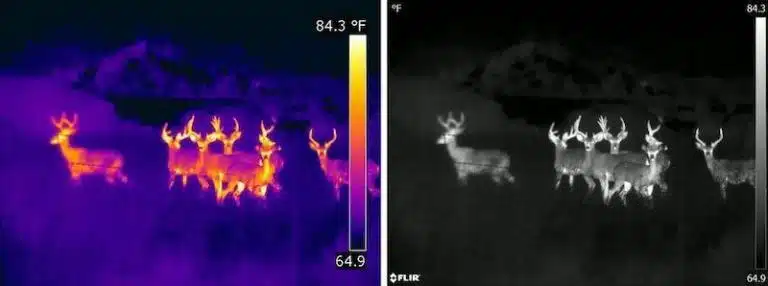
Night vision vs thermal imaging technologies enhance visibility in low-light or dark environments. While they aim to improve image, there are fundamental differences between the two technologies. This section introduces night vision vs thermal imaging and their purpose of enhancing visibility in challenging lighting conditions.
The principle of operation refers to the underlying mechanism by which technology functions to achieve its intended purpose. In the context of Night Vision and Thermal Imaging, understanding their principles of operation is essential to grasp how they enhance visibility in low-light or dark environments. Night Vision technology amplifies existing light, while Thermal Imaging detects and visualizes heat signatures. This short intro highlights the distinct approaches each technology takes to enhance visibility and sets the stage for further exploration of their principles of operation.
Night Vision technology works by amplifying existing light sources to provide enhanced visibility. It relies on image intensifier tubes or digital sensors to capture and amplify available light. These devices convert the captured light into electrical signals, which are then processed and displayed as visible images. By strengthening the existing light, Night Vision technology allows users to see more clearly in low-light environments.
Thermal Imaging operates based on detecting heat emitted by objects. It measures the infrared radiation that everything talks about due to their temperature. The technology converts infrared radiation into a visible image called a thermogram. In a thermogram, different colors or grayscale shades represent varying temperatures. This allows the user to visualize temperature differences and see the heat signatures of objects and living beings, irrespective of lighting conditions.
Image formation refers to the process by which visual information is captured and transformed into a visible image. In Night Vision, available light is amplified and presented as a green-hued image, allowing improved visibility in low-light conditions. In Thermal Imaging, heat emitted by objects is detected and converted into a thermogram, displaying temperature variations as different colors or grayscale shades. These technologies utilize distinct methods of image formation to enhance visibility in specific ways.
Night Vision devices typically produce a green-hued image, often associated with popular depictions of Night Vision technology. Early Night Vision devices used phosphor screens that converted the amplified light into a green light for improved contrast and reduced eye strain. However, modern Night Vision devices can offer various color modes or digital displays, allowing users to select the color palette that suits their preferences or specific requirements.
Thermal Imaging produces a grayscale or multicolored image known as a thermogram. In a thermogram, different colors or shades of gray represent varying temperatures. Warmer objects appear brighter, while more wondrous things appear darker. The color palette is based on a color gradient corresponding to the temperature range detected by the Thermal Imaging device. The thermogram allows users to visualize and differentiate objects based on their heat emissions rather than relying on light reflection.
Detection and visibility are key factors in assessing the effectiveness of technologies like Night Vision and Thermal Imaging. Night Vision amplifies existing visible light to enhance visibility in low-light conditions, while Thermal Imaging detects heat signatures to provide visibility in darkness. Both technologies have distinct approaches to detection and visibility, offering valuable tools for improved situational awareness and object identification.
Night Vision technology excels at detecting and amplifying existing visible light. By strengthening the available light sources, it allows users to see more clearly in low-light conditions. Night Vision devices effectively improve recognition and identification of objects, people, and potential threats in low-light environments.
Thermal Imaging is not reliant on visible light. Instead, it detects the heat signatures of objects and living beings. This means that Thermal Imaging is practical even in complete darkness or situations without visible light. It allows users to detect temperature differences and visualize heat-emitting objects, providing valuable information for various applications such as search and rescue, surveillance, or identifying concealed objects.
Night Vision and Thermal Imaging have diverse applications in various fields. Night Vision technology is commonly used in military operations, law enforcement, hunting, surveillance, navigation, and wildlife observation to improve visibility in low-light conditions. Thermal Imaging finds applications in search and rescue operations, firefighting, building inspections, electrical and mechanical diagnostics, wildlife monitoring, and security surveillance, enabling the detection of heat signatures and enhancing visibility in darkness or through visual obstructions.
Thermal Imaging is utilized in numerous areas, such as:
In summary, Night Vision vs Thermal Imaging technologies offers distinct approaches to enhancing visibility in low-light or dark environments. Night Vision technology amplifies existing light sources, improving visibility in low-light conditions by capturing and strengthening available light. On the other hand, Thermal Imaging detects and visualizes heat signatures, allowing users to see temperature differences and heat-emitting objects or living beings.
When considering their respective applications, understanding the differences between Night Vision vs Thermal Imaging is essential. Night Vision technology is primarily utilized when enhancing visible light is critical, such as military operations, hunting, or navigation. Thermal Imaging, on the other hand, excels in situations where there is little to no visible light and the detection of heat signatures is paramount, such as search and rescue missions, firefighting, or building inspections.
By comprehending the principles of operation, image formation, detection capabilities, and applications of Night Vision and Thermal Imaging technologies, individuals and professionals can make informed decisions about which technology suits their specific needs and requirements.
Disclaimer:
Nightvisioninsights.com’s content is for informative purposes only. We make no claims regarding the items’ accuracy, reliability, appropriateness, or availability. You use this material at your own risk. We may receive small Amazon Associate fees on eligible purchases. Our website’s items, brands, trademarks, and pictures belong to their owners.
Copyright © 2023 | Night Vision Insights | Development & Maintenance by MeheTech